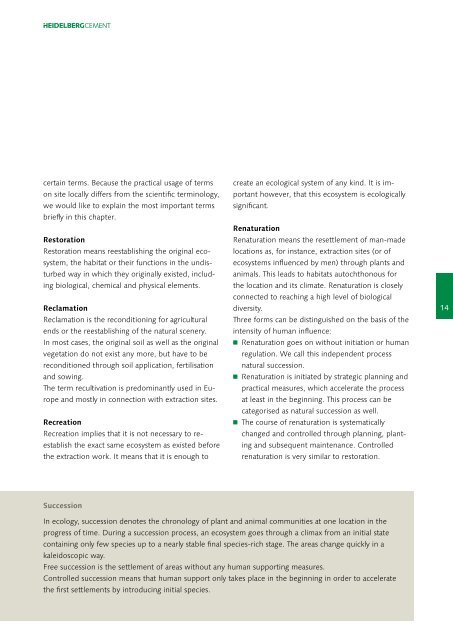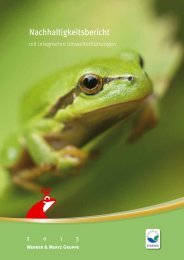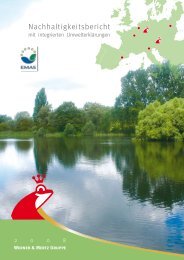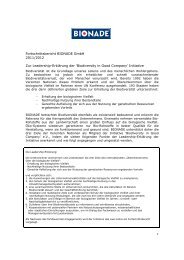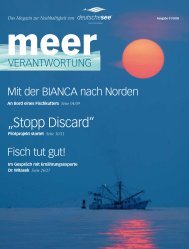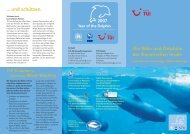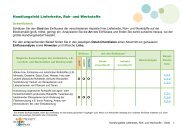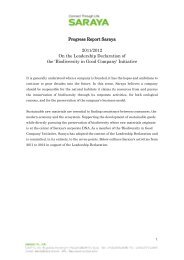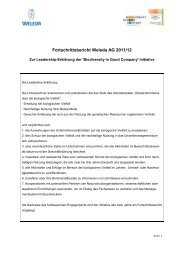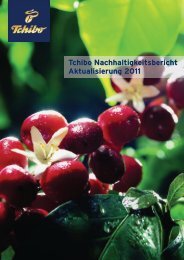Group guideline for the promotion of biodiversity - Business and ...
Group guideline for the promotion of biodiversity - Business and ...
Group guideline for the promotion of biodiversity - Business and ...
- No tags were found...
You also want an ePaper? Increase the reach of your titles
YUMPU automatically turns print PDFs into web optimized ePapers that Google loves.
certain terms. Because <strong>the</strong> practical usage <strong>of</strong> termson site locally differs from <strong>the</strong> scientific terminology,we would like to explain <strong>the</strong> most important termsbriefly in this chapter.RestorationRestoration means reestablishing <strong>the</strong> original ecosystem,<strong>the</strong> habitat or <strong>the</strong>ir functions in <strong>the</strong> undisturbedway in which <strong>the</strong>y originally existed, includingbiological, chemical <strong>and</strong> physical elements.ReclamationReclamation is <strong>the</strong> reconditioning <strong>for</strong> agriculturalends or <strong>the</strong> reestablishing <strong>of</strong> <strong>the</strong> natural scenery.In most cases, <strong>the</strong> original soil as well as <strong>the</strong> originalvegetation do not exist any more, but have to bereconditioned through soil application, fertilisation<strong>and</strong> sowing.The term recultivation is predominantly used in Europe<strong>and</strong> mostly in connection with extraction sites.RecreationRecreation implies that it is not necessary to reestablish<strong>the</strong> exact same ecosystem as existed be<strong>for</strong>e<strong>the</strong> extraction work. It means that it is enough tocreate an ecological system <strong>of</strong> any kind. It is importanthowever, that this ecosystem is ecologicallysignificant.RenaturationRenaturation means <strong>the</strong> resettlement <strong>of</strong> man-madelocations as, <strong>for</strong> instance, extraction sites (or <strong>of</strong>ecosystems influenced by men) through plants <strong>and</strong>animals. This leads to habitats autochthonous <strong>for</strong><strong>the</strong> location <strong>and</strong> its climate. Renaturation is closelyconnected to reaching a high level <strong>of</strong> biologicaldiversity.Three <strong>for</strong>ms can be distinguished on <strong>the</strong> basis <strong>of</strong> <strong>the</strong>intensity <strong>of</strong> human influence:■■ Renaturation goes on without initiation or humanregulation. We call this independent processnatural succession.■■ Renaturation is initiated by strategic planning <strong>and</strong>practical measures, which accelerate <strong>the</strong> processat least in <strong>the</strong> beginning. This process can becategorised as natural succession as well.■■ The course <strong>of</strong> renaturation is systematicallychanged <strong>and</strong> controlled through planning, planting<strong>and</strong> subsequent maintenance. Controlledrenaturation is very similar to restoration.14SuccessionIn ecology, succession denotes <strong>the</strong> chronology <strong>of</strong> plant <strong>and</strong> animal communities at one location in <strong>the</strong>progress <strong>of</strong> time. During a succession process, an ecosystem goes through a climax from an initial statecontaining only few species up to a nearly stable final species-rich stage. The areas change quickly in akaleidoscopic way.Free succession is <strong>the</strong> settlement <strong>of</strong> areas without any human supporting measures.Controlled succession means that human support only takes place in <strong>the</strong> beginning in order to accelerate<strong>the</strong> first settlements by introducing initial species.


